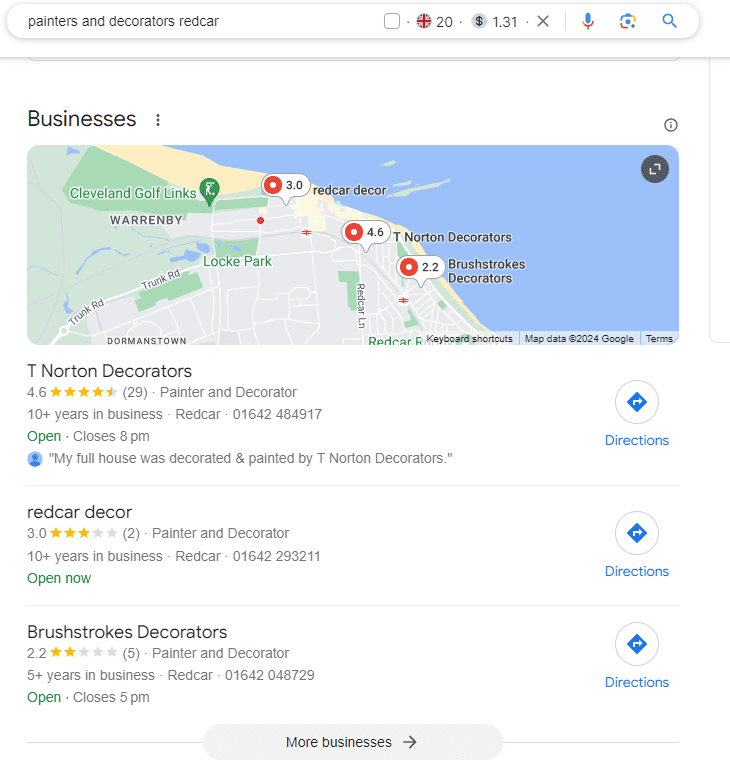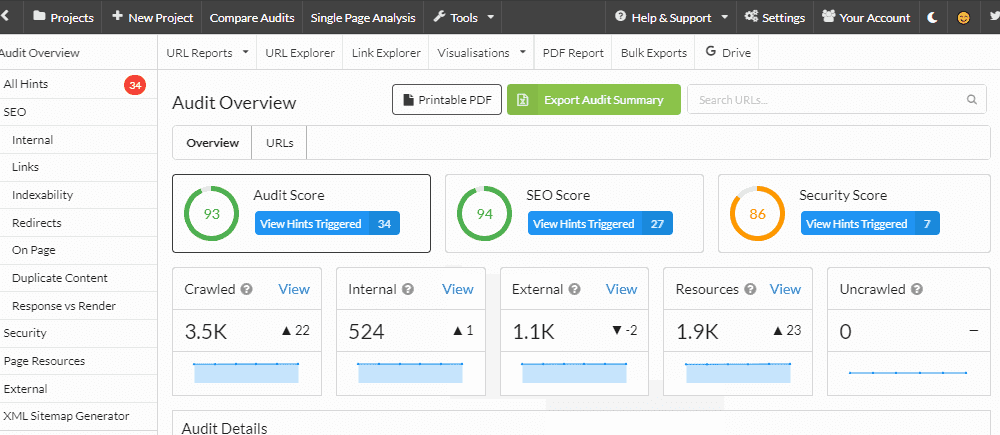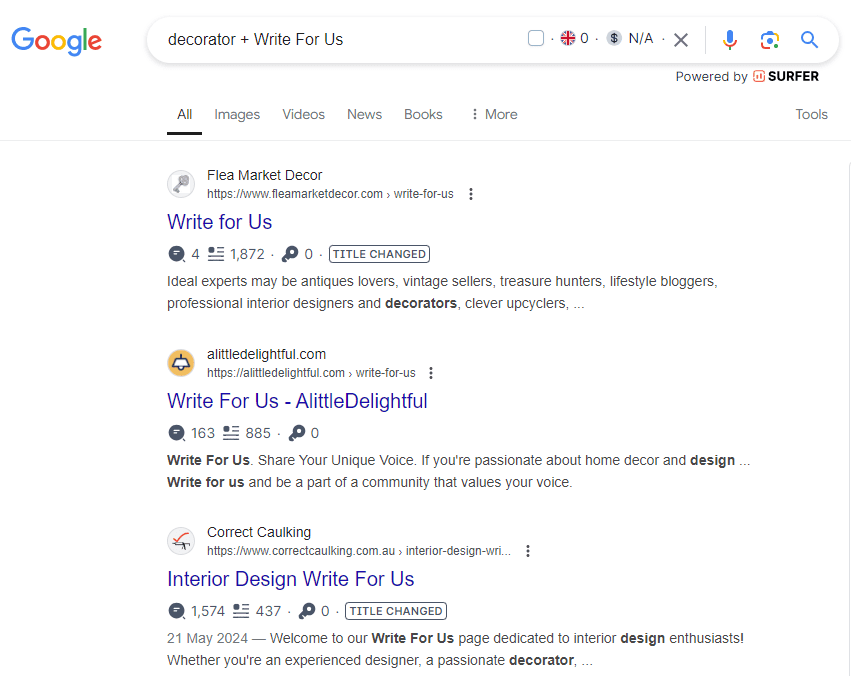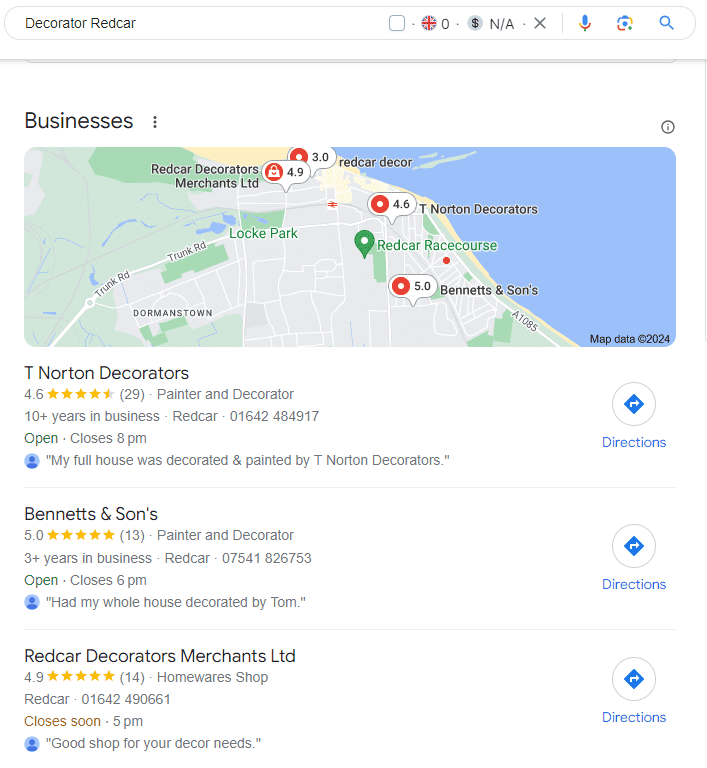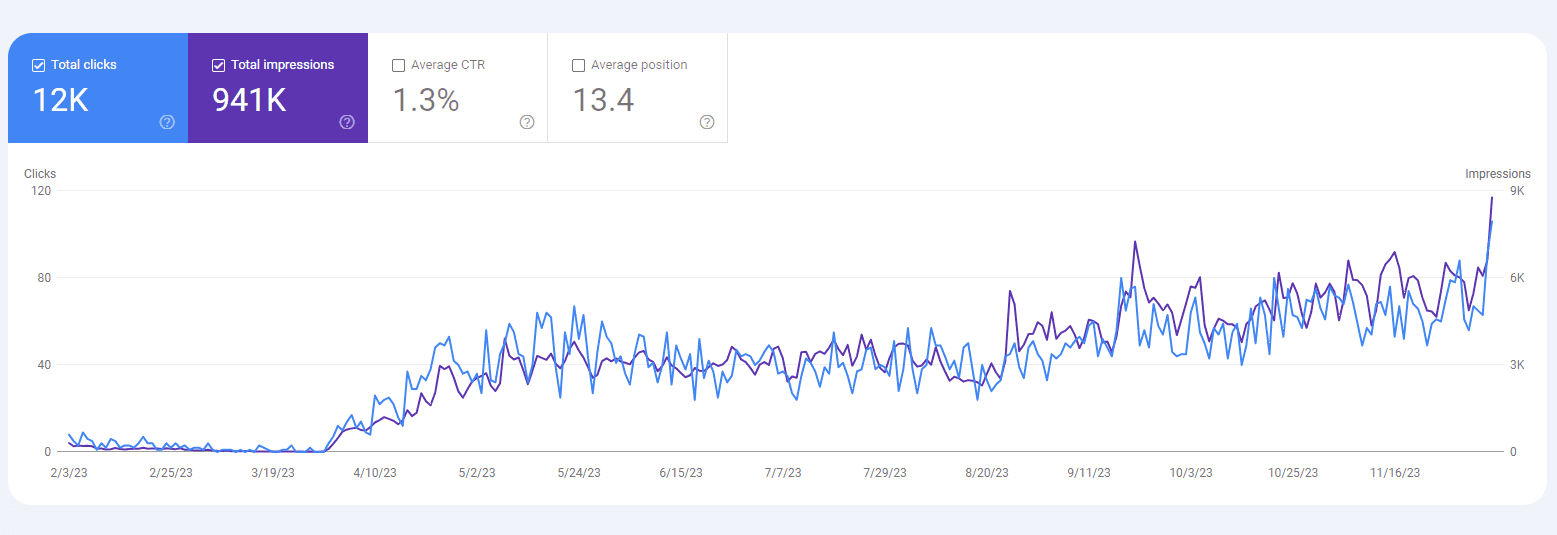Local SEO for Painters and Decorators:
Boost your painting and decorating business with my customised local SEO services for painters and decorators.
I’ll personally manage every facet of your SEO strategy, ensuring your business shines brighter than the rest, enhances your website traffic, and draws in more clients ready to use your services.
Forget the large agencies and impersonal SEO consultants—you’ll always have direct access to the person carrying out your SEO: me!
In need of impactful SEO for your painting and decorating business? Contact me today.
How do you do SEO for painters and decorators?
Here’s a step-by-step guide for 2024 that will help you utilise the best marketing channel: SEO.
Not interested in learning cause you’ve got better things to do, like transforming people’s homes?
Hire me as your local SEO expert, and I’ll get you ranked on Google so you can attract more paying customers.
Anyway, if you’re sticking around
Let’s get to it:
How Local SEO For Painters and Decorators Works
You don’t need me to tell you that word-of-mouth recommendations are the best way to get new clients to your business.
I’m sure you’ve experienced many great recommendations over the years after you’ve transformed someone’s living space with a lick of paint or a whole new wall.
But what if I told you there was a marketing technique that, once done right, could get you clients 24/7/365?
Now, I know it sounds too good to be true.
But this time around, it isn’t.
And no, you don’t need to pay millions or plant magic beans in your back garden.
You just need to utilise local SEO.
Local SEO for painters and decorators makes your website (& your business) more visible on search engines like Google and Bing.
Then, when prospects search for services like yours, which they do all year round, your business will be visible to them.
This will lead them to click on your site or your Google Business Profile (more on that later) and engage with your business.
Dialling you up to ask you to come round to give their kitchen a fresh lick of paint.
Just do me a favour; go to Google and search ‘painter and decorator [Your Town]’ real quick.
Here is what I see:
Do you see the businesses that come up?
These companies are currently getting all the attention from your prospects, thanks to putting the time into local SEO.
They’ve utilised local SEO techniques to do this;
Populating your website with high-quality content, optimising for local keywords, claiming and updating your Google Business Profile, earning local backlinks, encouraging and managing online reviews, and using location-based pages and services to target specific local audiences.
Want to have your business appear there instead?
I’ll cover it in this upcoming step-by-step.
For now, let’s look at on-page SEO, off-page SEO and SERPs;
What is On-Page SEO?
On-page SEO involves tactics you implement directly on your website to boost your visibility in Google’s search results, helping your painting and decorating business flourish locally.
While there are numerous on-page SEO tactics, I’ll delve deeper into these shortly with a comprehensive guide tailored for painters and decorators.
For the moment, here are some key strategies to remember:
- Optimising your title tags and meta descriptions to catch the eye
- Incorporating keywords relevant to painting and decorating throughout your site
- Uploading high-quality, descriptive images of your work
- Interlinking related pages to enhance user engagement with your content
- Ensuring your website loads quickly
- …and much more.
What is Off-page SEO?
Off-page SEO is a technique applied beyond your website to elevate your ranking in Google’s search results.
These strategies for painters and decorators can involve:
- Acquiring backlinks from relevant websites
- Gathering Google reviews from satisfied clients
- Contributing to guest posts and articles within the industry (also giving you a backlink)
What are SERPs?
SERPs stands for search engine results pages.
These are the pages you see after entering a search term on Google.
As mentioned, appearing on these pages is crucial to attracting new clients for your painting and decorating business.
Enough with the introductions; let’s dive into how to implement SEO for your painting and decorating services.
Local SEO for Painters and Decorators: 7-Step Guide
Now it’s time to FINALLY show a complete SEO for painters and decorators strategy.
Let’s goooooo:
0.5 Run an Audit of Your Site (If You Have One)
The very first thing you should ever do, if you have a website, is to run an audit to see any glaring issues that you should be dealing with
Way before you see what your competitors are doing, figure out the keywords you want to rank for
And definitely, before you start getting backlinks.
Think of a site audit as a health check-up for a website, similar to how you might visit a doctor for a physical exam.
It’s essential for SEO, which is all about making your site easy to find and rank higher on search engines like Google.
Here’s why doing a site audit first matters;
It helps you spot any problems hindering your website, preventing it from performing at its best.
For example, it can uncover issues like slow-loading pages, broken links, or messy navigation, which can frustrate visitors and make search engines less likely to show your site in search results.
Even if you have the best content on the web.
By finding and fixing these issues early, you ensure your website is set up correctly from top to bottom, giving it the best chance to attract more visitors.
Also, fixing these could make the difference in getting some quick movement on the SERPs, which could be beneficial to get your SEO campaign up and running ASAP.
When doing a site audit, many tools are out there to help you.
My current favourite is Sitebulb.
It’s as simple as downloading their app, entering your site for an audit, and adjusting the settings to your liking—like how thoroughly you want them to inspect your site.
Like that, you’ll get a comprehensive report of all issues neatly organised in a user-friendly dashboard.
Plus, you can export all these findings into a spreadsheet, making it easy to keep track of everything, no matter which computer you’re using.
This makes managing your website’s health straightforward and practical, ensuring you’re always on top of any problems affecting your SEO.
1. Start With Keyword Research
I’ve covered optimisation already, but before you can go ahead and optimise anything, you need to know what you’re optimising for
For example, you must know what keywords you will use throughout your site.
What are Keywords in SEO?: Keywords are specific words or phrases that people use to search for information on search engines like Google.
The best way to figure these out is to brainstorm phrases prospective clients might use to search for painter and decorator services.
I’ll give you a head start on some keywords:
- [Your Town] + painters
- [Your Town] + decorator
- [Your Town] + painters and decorators
- painters and decorators + [Your Town]
- Painters [Your Town]
But don’t take my word for it; you’ll want to find actual search volume data.
Why?
Because you want to make sure the keywords you’re using have provable traffic.
Or you’ll be building assets that only generate tumbleweed, not traffic.
I would recommend using Semrush for this.
Hop on over there, straight into the Keyword Overview section and see what the traffic data looks like for your brainstormed keywords.
At this point, it is time to sort them based on priority by prioritising the keywords you’ve gathered (the ones with search volume data) based on relevance and competition for your service pages.
You’ll also want to keep some more information keywords handy that you can use once you start creating local and national content on your blog.
2. Time to Use On-Page SEO
On-page is the process of optimising a page for Google SERPs.
Ideally, you’d optimise every page on your website, but this isn’t typically needed.
Just your most important ones; services pages and information pages.
Remember those keywords you’ve collected previously from Semrush?
Yeah, you’re going to need them now.
Here are some critical on-page SEO tips you need to follow:
- Keywords: These are the words or phrases people type into search engines when looking for something. Each page should focus on relevant keywords that tell search engines what the page is about. You’ll want to use them in your URL, title tag, meta description, h1, first sentence, h2, and last sentence.
- Content Quality: Your website’s content should be useful, interesting, and informative. High-quality content keeps visitors engaged and coming back for more, which search engines love because it shows your site is valuable.
- Page Titles and Descriptions: Each page should have a unique title and a description that explains its content. These appear in search results and can convince someone to click on your link.
- URL Structure: Each page’s web address should be precise and include key terms. It’s like having a straightforward path to your house that makes it easy for guests to find.
- Images and Tags: Pictures on your site should have descriptions, known as alt tags, which tell search engines what the images are showing. This is especially important if the image doesn’t load or if someone is using a screen reader because of a visual impairment.
- Mobile-Friendliness: With more people using smartphones to browse the internet, your site needs to look good and work well on mobile devices. It’s like making sure your house has doors wide enough for everyone to enter.
But this isn’t the end of our SEO journey.
You can do on-page perfectly, but it’s doomed if you don’t have a good backlink profile.
It’s time to acquire links (and not go against Google rules when doing so):
3. Get Backlinks
A backlink is created when another website links to yours.
Google views it as a vote of confidence, allowing you to rank better on the SERPs.
This critical ranking factor will only help if you acquire links from relevant sources to your niche.
So, in this case, as a painter and decorator, you would need links from other painter and decorator sites.
That would be the ideal.
Although it’s going to be unlikely, as these people are your competitors
The second best case would be to acquire links from trade business sites, as this is still within your niche.
Here are a few ways to get backlinks:
Create High-Quality Informative Content
You should be creating quality content on your website anyway.
It’s how you’re going to make sure people stick around.
But if you want backlinks, you need to create informative content.
What’s the difference?
In this strategy, you want to create content that is loaded with data so people have no other choice but to link back to the page.
Earning yourself a free & valuable link.
Here are some ideas you could use on your painter & decorator business site:
- Comparing decorating tools & stores
- Holidays influence on decorating choices and spending behaviours.
- Return on investment for different painting and decorating projects
- DIY vs. Professional Job Comparison
Create Interactive (Useful) Tools
Similar to the above, you’ll want to create interactive and valuable tools for your website to attract users.
Again, this is a great idea for attracting new eyes to your business and generating some easy backlinks.
I know you won’t be a coder (I’m not either), so I recommend using ChatGPT to help you create such tools.
Need ideas? Think of what you would love as a painter and decorator and what your clients would enjoy using.
Here are some to get you ahead; project cost calculator, paint calculator, style quiz, seasonal maintenance planner, wallpaper calculator
Broken Link Building
Here’s another effective way to get backlinks to your website: broken link building.
Here’s how it works:
First, use tools such as Broken Link Checker to discover websites with links pointing to content that no longer exists or doesn’t work.
Next, you can contact these website owners and offer to replace the broken link with a link to relevant content on your site.
If they agree, you create content that fits well in the spot where the broken link was.
This gets you a backlink.
Why this trick works;
Website owners usually appreciate this because you’re helping to enhance their website by fixing these links.
Guest Posting
The process starts with finding blogs or websites relevant to your niche that are accepting guest posts.
You can do this by searching “decorator + Write For Us.”
Once you identify a few potential sites, you can contact them with a proposal for a guest post.
In your proposal, include your topic idea that would add value to their readers.
If they accept your idea, you write and submit your article following their guidelines.
Once published, your guest post will include a backlink to your website.
This is beneficial because it helps increase your site’s visibility and credibility, and blog owners appreciate high-quality content for their readers for free.
Tip: If you come across a blog that wants you to pay to add a guest to their archive, pass. Not because it’s a bad idea, but plenty of blogs will let you do this for free. So don’t waste your cash.
4. Optimise Your Business for Local SEO
Local SEO means making your website more visible in a specific geographic area (the area where you do business).
And that’s critical for painters and decorators, which often serve specific geographic areas.
Here’s what you need to do:
Including your NAP on your website
Including your business’s name, address, and phone number (NAP) on your website is essential for local SEO.
This information should be consistent across your website and all online platforms where your business is listed.
Place your NAP in a prominent location on your site, like the footer or header, so it appears on every page.
This consistency not only helps search engines verify your business’s legitimacy and location but also makes it easy for customers to contact or visit your business.
Accurate and easily accessible NAP information can significantly enhance your search rankings and online presence.
Create content focused on your service area.
Local keywords are specific words or phrases that include the name of the location where your business is based.
For example, if you’re a painter and decorator in Redcar, in the North East, you should have a webpage titled “painter and decorator in Redcar, North East.”
Additionally, you should develop more content to show you’re knowledgeable in your field, allowing you to have topical authority.
A useful strategy is to explore the “People Also Ask” section on Google.
Simply search for keywords related to your services and see if this section comes up:
After learning about potential customers’ questions, you can answer them directly on your main webpage or create a new page dedicated to them.
5. Use Google Business Profile
A Google Business Profile allows you to manage your business in Google’s local pack.
This is the local pack I see when searching for ‘Decorators Redcar’:
As you can see, Google recommends the first 3 businesses when searching for this particular service in this particular area.
This is where you want your business to appear when someone searches for services you offer in your service area.
You must set up and verify your business’s Google Business Profile listing to do this.
Next, optimise your listing by doing the following:
- Ensure your Name, Address, and Phone (NAP) information is accurate and current.
- Provide a thorough description of your business.
- Add relevant photos of your business.
- Accurately categorise your business to reflect what you do.
Remember, Google is just one of many places online where you can list your business, but there are several other platforms you should also consider.
6. Get More Local Citations
Local citations are crucial for improving your visibility in search results specific to your area.
Here’s how to effectively gather more local citations for your business:
- Start with Niche-Relevant Directories: List your business in directories specific to your industry. This not only increases your chances of being found by potential customers who are looking for specific services like yours but also helps build your reputation within the niche.
- Focus on Geographically Specific Directories: Next, make sure your business is listed in directories specific to your geographical area. For instance, if your business is in Redcar, North East, look for directories that cater to businesses in this region. This local focus enhances your visibility among the local population, who are more likely to be your primary customers.
- Expand to Larger Directories: After covering niche and local directories, broaden your reach by getting listed in larger, well-known directories like Yelp and Yellow Pages. These directories have a vast audience and can significantly increase your exposure, driving more traffic to your business.
By methodically securing your presence across these directories—from niche to local to large—you will improve your local SEO and enhance your business’s credibility and reach.
Just make sure your NAP-W is accurate across all of your listings.
You don’t want to confuse potential prospects now.
7. Track Your Results
Once you’ve implemented the previous steps and your SEO is cooking, it’s essential to start tracking your SEO efforts.
This way, you can see what’s working and what’s not, allowing you to easily fix glaring holes.
Now, there are hundreds, probably thousands, of tools available to track your SEO results.
Most of them are much of a muchness, but here are the ones I’d recommend (and actually use myself):
Google Search Console
Google Search Console is a free tool from Google that provides reliable data about your website’s performance.
It connects directly to your domain, allowing you to track various metrics such as the number of impressions, clicks, and where your pages rank on search results.
With Google Search Console, you can dive deep into the details.
If you’re really into the specifics, you can examine each page individually to understand what’s working and what might be slowing down your local SEO efforts.
This detailed analysis can help you pinpoint exactly where to make improvements.
Semrush
Yes, it’s a paid tool, but it outshines free options like Google Search Console and Google Analytics.
It can easily become your go-to SEO toolkit.
This tool allows you to monitor your local SEO performance, conduct keyword research, analyse backlinks, audit your website, and much more.
But let’s focus on why it’s particularly effective for SEO performance:
Beyond all the usual things, like tracking clicks, impressions, keywords you’re ranking for and so on
You can see what your competitors are up to.
This allows you to tweak your local strategy to stay ahead.
This competitive insight is invaluable for refining your approach and achieving better results in local search rankings.
Google Analytics (GA4)
Google Analytics 4 (GA4) is a great tool for monitoring the effectiveness of your SEO strategies.
It helps you see what visitors do on your site, like which pages they visit and their actions.
This information is key to figuring out what’s working and what might need some tweaks.
GA4 is really useful for checking how your SEO efforts lead to important site actions, such as filling out forms or buying products.
You can see how users get to your site and what they do once they’re there.
In short, Google Analytics 4 isn’t just about counting site visitors.
It gives you a detailed view of how your SEO efforts are playing out, helping you make better decisions to improve your site’s performance.
SEO for Painters and Decorators: What's Next?
Now it’s time to decide:
You could try to manage SEO independently, balancing it with your daily tasks as a painter and decorator.
Or:
You could work with a professional SEO company like mine that is experienced in targeting and ranking for the most important keywords related to painters and decorators.
The choice is ultimately yours.
No matter what you decide:
Effective SEO for painters and decorators begins with taking action.
Don’t wait—yesterday was the best time to optimise your site.
Why Choose My Local SEO Services?
Choosing me and my local SEO services means entrusting your painting and decorating business to a local lad who genuinely cares about your success.
As a one-man band, you’ll have direct access to the 6+ years of experience you’re paying for, ensuring personalised attention and tailored strategies – I won’t be palming you off to inexperienced juniors or other freelancers under me; which plenty of ‘professionals’ in this area do.
With real-world experience working with global brands, I bring a wealth of knowledge to the table, making conquering the local market a manageable task.

